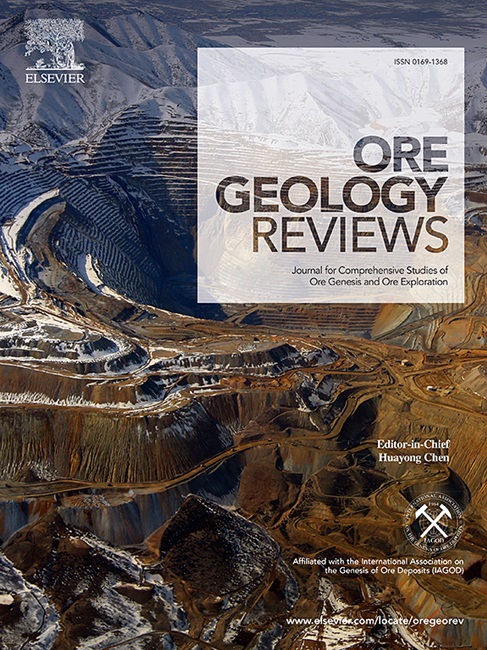塞尔维亚东部Veliki Krivelj斑岩-夕卡岩铜矿的石榴石年代学和矿物地球化学:对夕卡岩形成和热液流体演化的启示
IF 3.6
2区 地球科学
Q1 GEOLOGY
引用次数: 0
摘要
塞尔维亚Veliki - Krivelj大型斑岩-矽卡岩型铜矿位于特提斯成矿带西缘的Timok成矿区内。矿体主要赋存于蚀变安山岩、石英闪长斑岩、夕卡岩和大理岩中,受nnw向断裂控制。以往的研究主要集中在斑岩型铜成矿作用上,而对夕卡岩型铜成矿作用的系统认识仍然有限。在对夕卡岩矿体进行详细地质调查的基础上,重点研究了其中石榴石的年代学和元素地球化学特征。详细的岩石学研究表明,石榴石产于凝灰质角砾岩(Grt I)、石英闪长斑岩(Grt II)和大理岩(Grt III) 3个岩性单元中,具有多阶段的成分分带性:(1)Grt I表现为从Grt Ia (gro69 -75和25-30)→Grt Ib (gro44 -63和34-55)→Grt Ic (gro0 -14和86-99)的岩心到岩缘的演化过程,其特征是粗晶岩(Gro)逐渐亏缺,角长岩(and)逐渐富集;(2) Grt II从富al核心(Grt IIa: gro33 -46和52-66)向Fe3+主导的边缘(Grt IIb: gro1 -9和90-98)转变;(3) Grt III由纯andradite (gro0 -4和95-99)组成。微量元素分析表明,Grt Ia和Grt Ib表现出弱HREE富集,弱LREE亏缺,Eu异常弱或不存在,Y/Ho比值均匀,表明形成于一个以岩浆流体为主的低水岩比、近中性封闭体系。相比之下,Grt Ic、Grt IIa、Grt IIb和Grt III表现出LREE富集、HREE亏缺、明显的正Eu异常和可变的Y/Ho比,表明其形成于氧化、高水岩比、弱酸性开放体系,包括岩浆流体和大气水的可变贡献。石榴石U-Pb定年限制矽卡岩Cu成矿作用在86.4±1.9 Ma,与斑岩成矿作用(~ 88 Ma)和石英闪长斑岩侵位(85-87 Ma)同步。综合分析认为,斑岩与夕卡岩成矿属于同一岩浆-热液成矿体系的产物,石英闪长斑岩可能是Veliki Krivelj夕卡岩的母岩。该研究为指导矿区的进一步勘探提供了重要的矿物学约束。本文章由计算机程序翻译,如有差异,请以英文原文为准。

Garnet geochronology and mineral geochemistry of the Veliki Krivelj porphyry-skarn Cu deposit, eastern Serbia: Implications for skarn formation and hydrothermal fluid evolution
The Veliki Krivelj large porphyry-skarn Cu deposit in Serbia is located in the Timok metallogenic district on the western margin of the Tethyan metallogenic domain. The ore bodies are predominantly hosted in altered andesite, quartz diorite porphyry, skarn and marble, and are structurally controlled by NNW-trending faults. Previous studies have focused on porphyry Cu mineralization, while systematic understanding of skarn Cu mineralization remains limited. Based on detailed geological investigations of skarn orebodies, this study focuses on the geochronology and elemental geochemistry of garnet within them. Detailed petrographic investigations reveal that garnets occur in three lithological units: tuffaceous hornfels (Grt I), quartz diorite porphyry (Grt II), and marble (Grt III), exhibiting multistage compositional zoning: (1) Grt I displays core-to-rim evolution from Grt Ia (Gro69-75And25-30) → Grt Ib (Gro44-63And34-55) → Grt Ic (Gro0-14And86-99), marked by progressive depletion in grossular (Gro) and enrichment in andradite (And); (2) Grt II transitions from Al-rich cores (Grt IIa: Gro33-46And52-66) to Fe3+-dominant rims (Grt IIb: Gro1-9And90-98); (3) Grt III comprises pure andradite (Gro0-4And95-99). Trace element analyses indicate that Grt Ia and Grt Ib display weak HREE enrichment with LREE depletion, weak or absent Eu anomalies, and uniform Y/Ho ratios, suggesting formation in a reduced, low water/rock ratio, near-neutral closed system dominated by magmatic fluids. In contrast, Grt Ic, Grt IIa, Grt IIb, and Grt III exhibit LREE enrichment with HREE depletion, pronounced positive Eu anomalies, and variable Y/Ho ratios, indicative of formation in an oxidized, high water/rock ratio, weakly acidic open system involving both magmatic fluids and variable contributions from meteoric water. Garnet U-Pb dating constrains skarn Cu mineralization at 86.4 ± 1.9 Ma, coeval with porphyry mineralization (∼88 Ma) and quartz diorite porphyry emplacement (85–87 Ma). Comprehensive analysis suggests that the porphyry and skarn mineralization belong to the products of the same magmatic-hydrothermal mineralization system, and the quartz diorite porphyry may be the parental rock of the Veliki Krivelj skarn. This study provides critical mineralogical constraints for guiding further exploration in the mining area.
求助全文
通过发布文献求助,成功后即可免费获取论文全文。
去求助
来源期刊

Ore Geology Reviews
地学-地质学
CiteScore
6.50
自引率
27.30%
发文量
546
审稿时长
22.9 weeks
期刊介绍:
Ore Geology Reviews aims to familiarize all earth scientists with recent advances in a number of interconnected disciplines related to the study of, and search for, ore deposits. The reviews range from brief to longer contributions, but the journal preferentially publishes manuscripts that fill the niche between the commonly shorter journal articles and the comprehensive book coverages, and thus has a special appeal to many authors and readers.
 求助内容:
求助内容: 应助结果提醒方式:
应助结果提醒方式:


